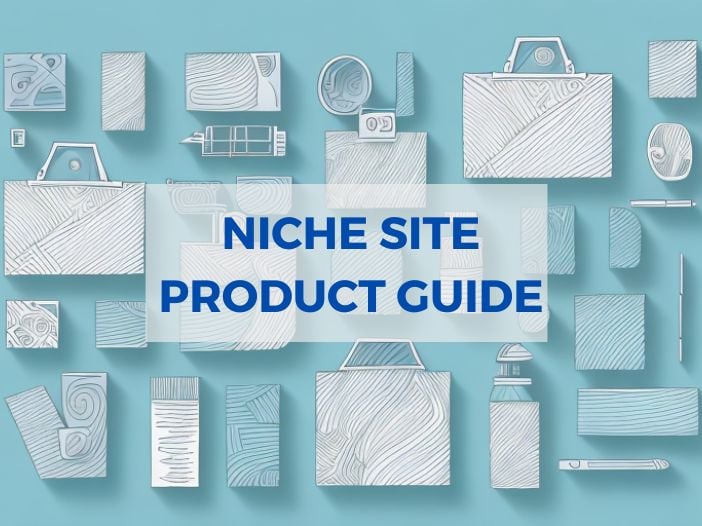Deciding on products is a big decision for your niche website.
Adding the wrong type or low-quality products can negatively impact your income and brand.
Too few products and your site may seem sparse and uninteresting, but too many products, and you risk overwhelming your visitors and diluting your brand.
In this article, I’ll explore the factors to consider when selecting and strategizing the number of products on your niche site, so you can create a high-performing site that meets the needs of your target audience.
Pros and Cons of Having Niche Site Products
Benefits of a niche site
Niche sites offer a number of benefits for site owners and their audiences:
- High conversion rates and targeted traffic – by serving a specific niche, your site can attract visitors actively searching for solutions to their problems. Your site is more likely to convert visitors into customers, as they are already interested in your products or services.
- Lower competition – because you’re not competing with broad-market websites, you’re more likely to rank higher in search engine results for keywords relevant to your niche. This means your site is more likely to be seen by your target audience, increasing your traffic and potential sales.
- Clear value proposition – given the highly specialized nature of niche sites, your audience will quickly understand your site’s value and be more likely to engage with your content and products. This means that your site is more likely to build a loyal following of customers who trust your brand and are willing to purchase from you repeatedly.
Challenges of a niche site
While niche sites offer many benefits, they can also present a number of challenges for site owners:
- Narrow audience – because you’re targeting a specific audience segment, you’ll need to generate high traffic levels to ensure profitability. This means you’ll need to invest time and resources into marketing your site to your target audience through social media advertising, search engine optimization, and content marketing.
- Product scarcity – depending on your niche, a limited range of products may be available to promote to your audience. This means you’ll need to be creative in finding relevant products for your audience by partnering with niche suppliers or creating your own products.
- Hyper-targeted content – to appeal to your audience, you’ll need to create highly specific and valuable content, which can be time-consuming and labor-intensive. This means you’ll need to invest in high-quality content creation, such as by hiring freelance writers or creating your own content.
Despite these challenges, niche sites can be incredibly profitable and rewarding for site owners willing to invest the time and resources needed to succeed.
By focusing on a specific audience segment and providing valuable content and products, niche sites can build a loyal following of customers who trust and rely on your brand.
Factors to consider when selecting products for a niche site
When selecting products for your niche site, it’s essential to consider the following factors:
Target audience and their needs
Your audience should be the starting point for your product selection.
Consider what types of products would best serve their needs, challenges, and interests.
What are they searching for? What problems are they trying to solve?
Depending on your niche, you may need to research your audience to determine their product preferences.
For instance, if your niche is fitness, you’ll consider the different types of fitness enthusiasts who may visit your site.
Are they interested in weightlifting, running, yoga, or something else? What are their fitness goals? Do they want to lose weight, build muscle, or improve their overall health?
Understanding your audience’s needs and interests will help you choose relevant and valuable products.
Product relevance to the niche
Ensure that the products you select are directly related to your niche and complement your site’s content.
Avoid promoting unrelated products that don’t provide significant value to your audience. Your products should align with your site’s overall branding and messaging.
For example, if your niche is sustainable living, you’ll want to choose eco-friendly products that align with your site’s message of reducing waste and promoting sustainability.
This could include products like reusable grocery bags, compost bins, or solar-powered chargers.
Market Demand and competition
It’s essential to assess the level of demand for the products you’re considering, as well as the level of competition.
If there is high demand for a particular type of product but many competitors in the space, it may be challenging to gain traction.
Conversely, if there is low demand and little competition, you may be wasting your time promoting a product that isn’t in high demand.
One way to gauge market demand is to use keyword research tools to see how many people search for specific products or product categories.
You can also look at social media trends and industry reports to understand what products are popular in your niche.
Profitability and pricing
Your product selection should also take into account your site’s goals and profitability.
Consider the commission rates offered by the products you’re considering, as well as their price point.
A product with a lower price may require higher conversion rates to generate substantial revenue, while a higher-priced product may have a higher barrier to entry for your audience.
It’s also important to consider the lifetime value of a customer when selecting products.
For example, if you’re promoting a subscription service with a recurring monthly fee, you may earn less on the initial sale but more over time as the customer continues to subscribe.
Ultimately, selecting products for your niche site requires a balance of understanding your audience’s needs, choosing products that align with your site’s message, and assessing market demand and profitability.
By taking the time to research and select the right products, you can build a successful niche site that provides value to your audience and generates revenue for your business.
Determining the optimal number of products
Once you’ve selected your products, it’s time to determine the optimal number to offer on your niche site. Consider each of the following factors:
Analyzing your niche’s product range
Start by analyzing the product range within your niche.
Is there a broad array of products available, or is the range limited? Understanding the product range within your niche is crucial to determining the optimal number of products to offer on your site.
If your niche has a broad array of products available, it may be tempting to offer a large number of products.
However, if the range is limited, it may be more beneficial to focus on offering a smaller number of high-quality products that meet the needs of your audience.
When analyzing the product range within your niche, consider how your audience may want to shop.
Are they looking for a variety of options or a single solution? Understanding your audience’s needs and preferences will help you determine the optimal number of products to offer on your site.
Balancing variety and focus
Depending on your niche and the needs of your audience, you may need to strike a balance between offering variety and maintaining focus.
If your site is hyper-focused on a specific solution, consider offering a range of products within that category.
For example, if your niche is fitness, and your site focuses on yoga, consider offering a range of yoga mats, blocks, straps, and other accessories that cater to the needs of yogis.
If your niche is broad and varied, offering a more extensive product range may be beneficial.
For example, if your niche is home decor, you can offer a range of products that cater to different styles, such as modern, traditional, and bohemian.
Assessing your site’s capacity and resources
Consider the resources you have available to manage and promote your products.
Do you have the capacity to create and distribute content around each product effectively? Are you able to manage the logistics of order fulfillment and customer service for a large number of products?
Weigh these factors against your audience’s needs and the potential revenue each product may generate.
It may be tempting to offer a large number of products, but if you don’t have the resources to manage and promote each product effectively, it may be more beneficial to focus on a smaller number of high-quality products that meet the needs of your audience.
Ultimately, determining the optimal number of products to offer on your niche site requires a careful balance of understanding your audience’s needs, analyzing your niche’s product range, and assessing your site’s capacity and resources.
By considering these factors, you can offer a range of high-quality products that meet the needs of your audience and drive revenue for your site.
Strategies for expanding your niche site’s product offerings
Expanding the product offerings on your niche site is a great way to grow your business and increase revenue.
However, finding new products that fit your niche and appeal to your audience can be challenging.
Here are some strategies you can use to expand your product offerings:
Diversifying within your niche
If you’ve exhausted the product offerings within your niche, it’s time to think outside the box.
Consider branching out into related or complementary products that appeal to your audience.
For example, if your niche is fitness, you could expand your product offerings to include workout gear, supplements, and healthy snacks.
When diversifying within your niche, staying true to your brand is essential.
Ensure the products you offer align with your site’s mission and values. If you start offering products that don’t fit your niche, you risk alienating your audience and diluting your brand.
Collaborating with complementary businesses
Partnering with other businesses that offer complementary products or services is a great way to expand your product range and reach new audiences.
Look for businesses with a similar target audience but offer products different from yours.
For example, if your niche is home decor, you could partner with a furniture store to offer a wider range of products.
This would allow you to expand your product offerings without investing in new inventory or production.
Regularly reviewing and updating your product selection
It’s important to regularly evaluate and update your product selection as your niche evolves and new products become available.
Keep track of what products are selling well and not resonating with your audience.
Listen to your audience’s feedback and monitor industry trends to stay ahead of the curve. This will help you identify new products to add to your site and remove products that are no longer relevant.
Updating your product selection can also help you attract new customers and keep existing customers engaged. By offering fresh, new products regularly, you can create a sense of excitement and anticipation among your audience.
In conclusion, expanding your niche site’s product offerings requires creativity, strategic thinking, and a willingness to take risks.
By diversifying within your niche, collaborating with complementary businesses, and regularly reviewing and updating your product selection, you can grow your business and increase revenue.
The Bottom Line
The number of products you offer on your niche site should always be based on your audience’s needs, your site’s goals, and your available resources.
There is no one-size-fits-all approach to product selection, but by taking a strategic approach and considering the feedback you receive from your audience, you can create a profitable and thriving niche site.





